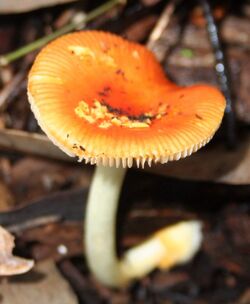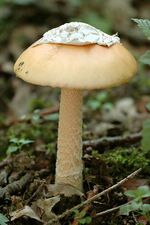Biology:Amanita xanthocephala
| Vermilion grisette | |
|---|---|

| |
| Amanita xanthocephala, Sylvan Grove Native Gardens, Picnic Point, Sydney | |
| Scientific classification | |
| Domain: | Eukaryota |
| Kingdom: | Fungi |
| Division: | Basidiomycota |
| Class: | Agaricomycetes |
| Order: | Agaricales |
| Family: | Amanitaceae |
| Genus: | Amanita |
| Species: | A. xanthocephala
|
| Binomial name | |
| Amanita xanthocephala (Berk.) D.A. Reid & R.N. Hilton (1980)
| |
Amanita xanthocephala, known as the vermilion grisette, pretty grisette or vermilion amanita is a colourful mushroom of the genus Amanita. It is found in south Australia in association with Eucalyptus and may be toxic to humans.
Taxonomy
At one stage this fungus was known as A. pulchella, in a small genus that all grisettes (ringless Amanita species) were placed in. This genus later sunk back into Amanita. Unlike most ringless Amanita, which are part of Amanita section Vaginatae (e.g. A. vaginata), A. xanthcephala belongs to Amanita section Amanita (e.g. A. muscaria).[1]
It derives its specific epithet xanthocephala from the Greek xanthos/ξανθοѕ "yellow" and kephale/κεφαλη "head".[2]
Description
It is a ringless mushroom with a yellowish- to reddish-orange cap up to 3–5 centimetres (1–2 inches) in diameter, with deeper colour toward the centre, and paler similar-coloured warts. The gills and slim ringless stipe are pale yellow or white. The white volva has a neat outturned lip and is often bordered with orange or yellow.[3]
Distribution and habitat
A. xanthocephala is distributed in southwest Western Australia, as well as southeastern Australia from around Adelaide to Southeast Queensland. It is particularly found in eucalypt forests, as it has an ectomycorrhizal relationship with Eucalyptus.[3]
Toxicity
Like its relative A. muscaria, it is reported to be toxic.[citation needed] There is one report of a person being quite ill after tasting a small piece of it in 1997.[4]
See also
References
- ↑ "Amanita fulva (Schaeff.) Fr". http://pluto.njcc.com/~ret/amanita/species/fulva.html.
- ↑ Liddell, Henry George and Robert Scott (1980). A Greek-English Lexicon (Abridged ed.). United Kingdom: Oxford University Press. ISBN 0-19-910207-4.
- ↑ 3.0 3.1 Grey P (2005). Fungi Down Under:the Fungimap Guide to Australian Fungi. Melbourne: Royal Botanic Gardens. p. 21. ISBN 0-646-44674-6.
- ↑ Ducker, S. (1997). "Toadstool causes broken bone". Australian Mycological Newsletter 16 (2): 39. ISSN 1322-1396. http://bugs.bio.usyd.edu.au/AustMycolSoc/Journal/1997/ISS16(2)_June97.pdf. Retrieved 2006-10-12.
External links
Wikidata ☰ Q4033869 entry
 |


